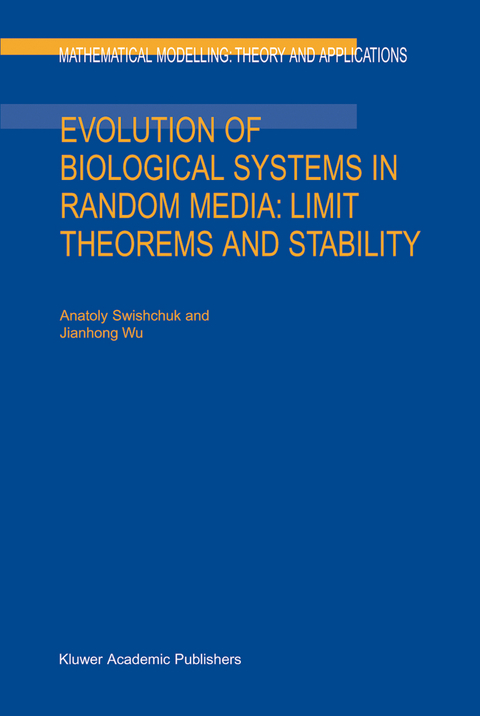
Evolution of Biological Systems in Random Media: Limit Theorems and Stability
Seiten
2003
Springer-Verlag New York Inc.
978-1-4020-1554-0 (ISBN)
Springer-Verlag New York Inc.
978-1-4020-1554-0 (ISBN)
Containing stochastic non-linear models of biological systems, this book in biomathematics presents results for scalar and vector difference equations in random media with applications to the stochastic biological systems. It also offers an approach to the study of stochastic biological systems in random media such as random evolution approach.
The book is devoted to the study of limit theorems and stability of evolving biologieal systems of "particles" in random environment. Here the term "particle" is used broadly to include moleculas in the infected individuals considered in epidemie models, species in logistie growth models, age classes of population in demographics models, to name a few. The evolution of these biological systems is usually described by difference or differential equations in a given space X of the following type and dxt/dt = g(Xt, y), here, the vector x describes the state of the considered system, 9 specifies how the system's states are evolved in time (discrete or continuous), and the parameter y describes the change ofthe environment. For example, in the discrete-time logistic growth model or the continuous-time logistic growth model dNt/dt = r(y)Nt(l-Nt/K(y)), N or Nt is the population of the species at time n or t, r(y) is the per capita n birth rate, and K(y) is the carrying capacity of the environment, we naturally have X = R, X == Nn(X == Nt), g(x, y) = r(y)x(l-xl K(y)) , xE X.
Note that n t for a predator-prey model and for some epidemie models, we will have that X = 2 3 R and X = R , respectively. In th case of logistic growth models, parameters r(y) and K(y) normaIly depend on some random variable y.
The book is devoted to the study of limit theorems and stability of evolving biologieal systems of "particles" in random environment. Here the term "particle" is used broadly to include moleculas in the infected individuals considered in epidemie models, species in logistie growth models, age classes of population in demographics models, to name a few. The evolution of these biological systems is usually described by difference or differential equations in a given space X of the following type and dxt/dt = g(Xt, y), here, the vector x describes the state of the considered system, 9 specifies how the system's states are evolved in time (discrete or continuous), and the parameter y describes the change ofthe environment. For example, in the discrete-time logistic growth model or the continuous-time logistic growth model dNt/dt = r(y)Nt(l-Nt/K(y)), N or Nt is the population of the species at time n or t, r(y) is the per capita n birth rate, and K(y) is the carrying capacity of the environment, we naturally have X = R, X == Nn(X == Nt), g(x, y) = r(y)x(l-xl K(y)) , xE X.
Note that n t for a predator-prey model and for some epidemie models, we will have that X = 2 3 R and X = R , respectively. In th case of logistic growth models, parameters r(y) and K(y) normaIly depend on some random variable y.
1 Random Media.- 2 Limit Theorems for Difference Equations in Random Media.- 3 Epidemic Models.- 4 Genetic Selection Models.- 5 Branching Models.- 6 Demographic Models.- 7 Logistic Growth Models.- 8 Predator-Prey Models.
| Reihe/Serie | Mathematical Modelling: Theory and Applications ; 18 |
|---|---|
| Zusatzinfo | XX, 218 p. |
| Verlagsort | New York, NY |
| Sprache | englisch |
| Maße | 155 x 235 mm |
| Themenwelt | Informatik ► Weitere Themen ► Bioinformatik |
| Mathematik / Informatik ► Mathematik ► Angewandte Mathematik | |
| Naturwissenschaften ► Biologie | |
| ISBN-10 | 1-4020-1554-2 / 1402015542 |
| ISBN-13 | 978-1-4020-1554-0 / 9781402015540 |
| Zustand | Neuware |
| Haben Sie eine Frage zum Produkt? |
Mehr entdecken
aus dem Bereich
aus dem Bereich
Internationale statistische Klassifikation der Krankheiten und …
Buch | Softcover (2023)
Deutscher Ärzteverlag
CHF 34,95
Operationen- und Prozedurenschlüssel; Internationale Klassifikation …
Buch | Softcover (2023)
Deutscher Ärzteverlag
CHF 34,95


